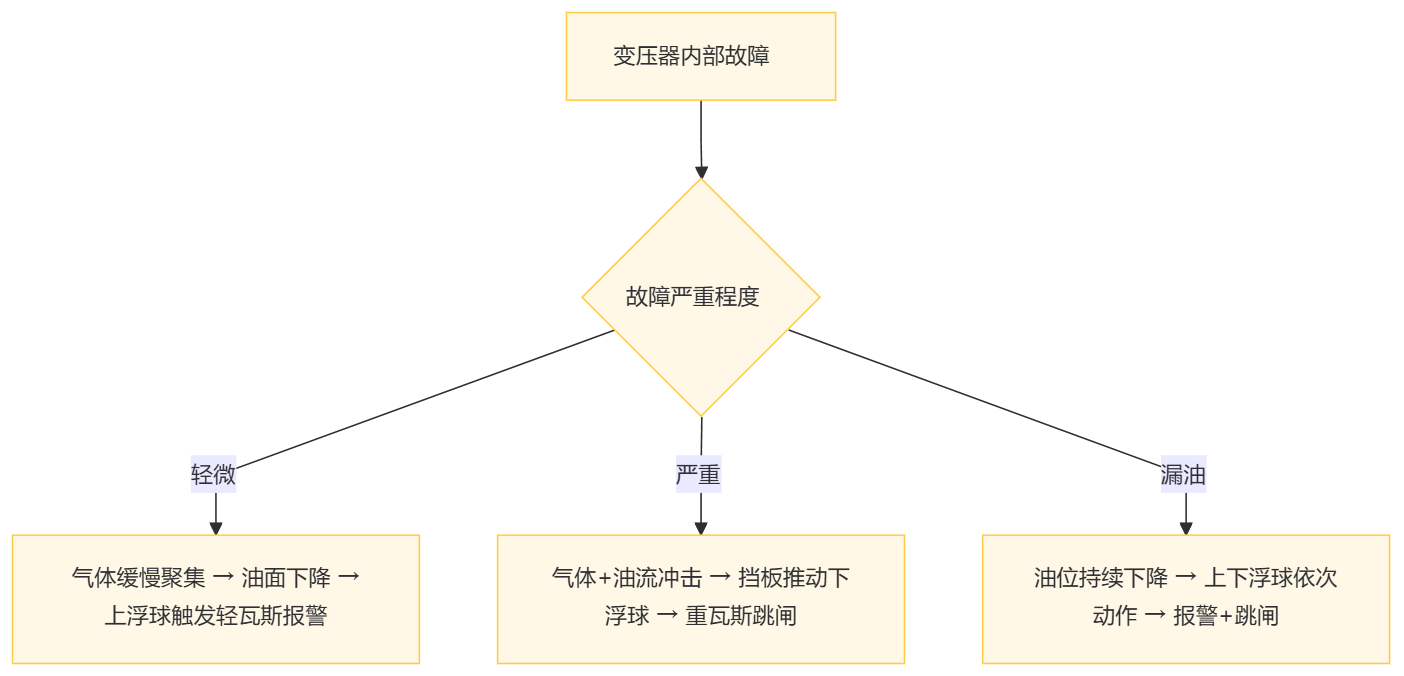Double Float Transformer Gas Relay
Date: July 15, 2025 08:27:10
Structure and working principle:
-
Double float design: There are two floats, upper and lower, corresponding to the light gas alarm and heavy gas trip function.
-
booby-trap(Light Gas Alarm): When a small amount of gas is generated by a minor fault inside the transformer, the gas gathers in the upper layer of the relay, the oil level drops, the floating ball drops, triggering the reed node to close and issuing a light gas alarm signal.
-
lower float(Heavy gas trip): When the transformer internal serious failure (such as short circuit) lead to a large amount of gas and oil flow impact baffle, or serious oil leakage so that the oil level drops, the lower float loses buoyancy decline, trigger heavy gas trip node, cut off the transformer power .
-
-
Baffle StructureThe oil flow impacting the baffle plate can make the lower float act and trigger the tripping signal.
Applications and Benefits:
-
220kV and above transformer bodyIt is recommended to use a gas relay with double floats and baffle construction to improve safety.
-
Compared to single float relays, dual float relays can better differentiate between minor and serious faults, avoiding safety hazards caused by serious oil leaks or malfunctions.
Other features:
-
test functionThe relay can be manually triggered for light or heavy gas operation by means of a test thimble on the upper part of the relay, which makes it easy to check the function of the relay.
✅ normal state of operation
-
Internal RelayFilled with insulating oilThe upper and lower floats are buoyant.all go upReed contactsturn off (electric switch), no signal output.
✅ Fault triggering mechanism
| Fault type | physical phenomenon | ballooning | output signal |
|---|---|---|---|
| minor breakdown(e.g. partial discharge, overheating) | A small amount of gas precipitates out and collects at the top of the relay, the oil level slowly decreases | booby-trapTriggered as the oil level dropsReed contact closure | Light gas alarm(Signal node output) |
| serious malfunction(e.g., turn-to-turn short circuits, arc discharges) | Large amount of gas generation + high speed flow of oil into the oil pillow | Oil flow impact baffleThe float drops rapidly when pushed by the baffle plate, triggering theReed contact closure | Heavy gas tripping(trip node output, cuts power to transformer) |
| Severe oil leakage | The oil level continues to drop and the oil level is below the lower float ball | Upper and lower floatlose buoyancy one after anotherThe light and heavy gas signals are triggered sequentially. | Light gas alarm first, then heavy gas trip |
✅ Accessibility
-
manual test: via the top of the relayTest ThimblesFloat action can be simulated to verify contact function (light press triggers light gas, heavy press triggers heavy gas).
-
Anti-misalignment design: Some of the newer relays have been adopted byAnalysis of variance for pressure changesIdentify fault areas to avoid out-of-area faults causing false trips.
✅ Key parameters
-
Light Gas Alarm Gas Volume:: Approximate 250~300 mL
-
Heavy gas trip oil flow rate: Regular 0.6~1.2 m/s(Strong oil circulation transformers up to 1.4 m/s)
📌 Summarize the flowchart

Transformer internal failure
Failure severity
Gas slowly builds up → oil level drops → floating ball triggers light gas alarm
Gas + oil flow impact → baffle pushes down float → heavy gas trip
Oil level continues to drop → upper and lower floats act sequentially → alarm + trip













